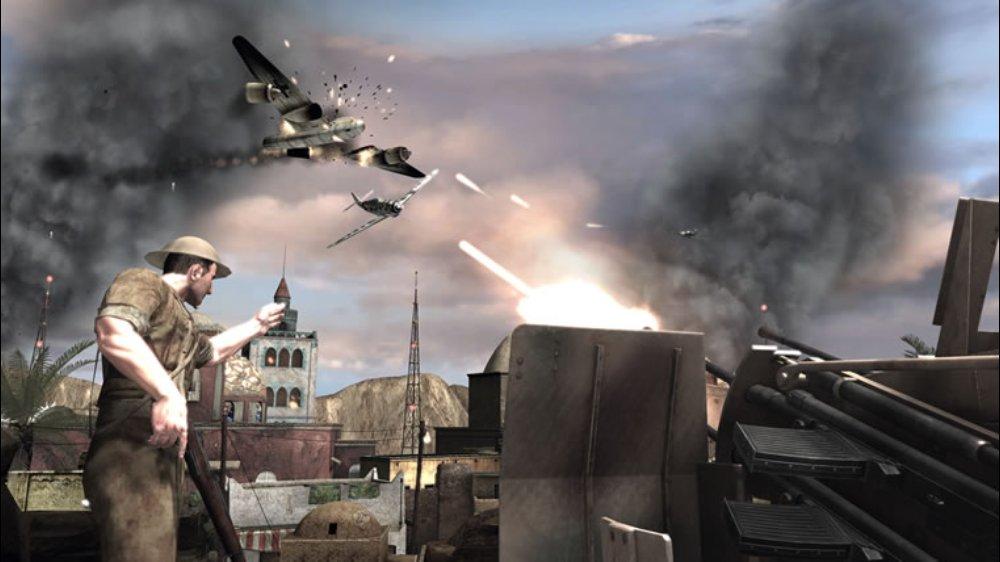You can trust VideoGamer. Our team of gaming experts spend hours testing and reviewing the latest games, to ensure you're reading the most comprehensive guide possible. Rest assured, all imagery and advice is unique and original. Check out how we test and review games here
These days a new ‘triple-A’ first-person-shooter is a standard inclusion on each page of the gaming calendar. It would almost be bigger news if a week passed without one being released on one format or another, and none are more popular than World War II themed shooters made fashionable by Medal of Honor and Call of Duty.
The latest big budget action WWII game with a three letter acronym is Hour of Victory, due for release on the 360 by the end of summer 2007, and just like its predecessors it’s a glossy interpretation of the tooth-and-nail battles that defined the outcome of the world’s most horrific conflict.
Everything you would expect from a respectable FPS seems present and correct from the hands-on I was invited to enjoy in the snowy mountains of Austria, but there is little point dwelling on what we have seen before a dozen times or more. The real issue with Hour of Victory is what it offers to distinguish itself from the competition.
The game’s developers are keen to point to stylistic differences, comparing their new work to classic war movies like Where Eagles Dare, as opposed to the gritty Saving Private Ryan feel of Call of Duty. However, though it is always refreshing for a game to take a new aesthetic direction, what truly marks out a distinct game is distinct gameplay. Thankfully it would seem that HOV at least goes someway to differentiate its gameplay in a genre overcrowded with clones.
Turning a blind eye to the current trend for team-based combat and tactical set piece shooting, the game’s defining quality is certainly its three unique playable characters. At marked points in each level you can switch instantly between any one of three different soldiers with contrasting abilities.
The first of the typically masculine grunts on offer is Ross, a British trooper who serves as your mainstay for head-on fire fights and gunplay. His emphasis is on brute strength and firepower, meaning he can take more hits, deliver more damage and move weighty objects too heavy for his allies. The second playable character available is Taggart, a covert-ops specialist who can cut open fences and pick locks, revealing hidden routes and tactical vantage points. Finally there is Bull, a sniper with the appropriate long-ranged rifle, who also has a small grappling hook, allowing him to climb to vantage points and alternative routes. Bull is also blessed with the ability to make substantially larger jumps than his team mates, allowing him to scout ahead and leap across rooftops like a vintage superhero.
What is clever are not the various talents that each of these characters offer, but the dynamic way they are applied to the game itself. As you progress through the predicable but wonderfully realised back streets and deserted building shells, you are never obliged to stick rigidly to using a certain combatant. Of course, certain level sections are designed to encourage using a particular team member, but it seems that it is rare for there to be only one prescribed combination of the three troopers that can be used to reach a goal.
For example, in the North Africa level, an objective requiring scaling a hill defended by a powerful and all-seeing machine gun post allowed for a thrilling, non-linear approach that encouraged experimentation and regular character switching. Using all rounder Ross, zigzagging up the main road towards the fearsome enemy made for a risky but direct route that saved time and effort, while lock picking your way with Taggart to emerge behind the Nazi drone or clabbering to a vantage point with Bull allowed for a more considered playing style.
The abilities and applications of Ross, Taggart and Bull are nicely balanced and divided, meaning that in most cases it appears you will use a combination of all three at almost every stage of each level, working forward with each to tackle different enemies. It does look like this might mean a fair bit of backtracking to switching points, as unlike Commandos on the PlayStation 2 or even Cannon Fodder, you cannot leave the player characters you are not using at tactical points to function independently.
Of course in reality, for the player new to each level’s nuances, working through a stage involves trial and error with each soldier until you overcome the obstacles ahead with the right combination of individual and technique. It would be easy to dismiss HOV’s approach to gameplay as a dressed up version of the PSone Medal of Honor games, where players followed several potential dead ends until they stumbled upon the correct route. However, at least from the demonstrations and hands-on time, it feels that each level is designed so as to allow the player to develop their own solution, rather than demanding they figure out the only solution.
Core game mechanic aside, it looks like HOV is all set to be released as a highly polished FPS, with some nice physics and fantastic graphics. Each level seen was packed with excellent detail, with debris and rubbish littering every area, lending a brilliantly natural feel to the release, that also highlights how premeditated many game worlds can feel.
The line between giving FPS fans what they expect and offering them a fresh and original gameplay experience is a fine one indeed, but it seems that Midway’s latest WWII adventure is ready to tackle that challenge. Though it will do nothing to revolutionise gaming at all, it will certainly add some depth to a genre that cannot provide enough new, high quality output fast enough. As Hour of Victory draws near, we can only hope that it is as good as it promises to be.
/https://oimg.videogamer.com/images/53aa/hour_of_victory_2.jpg)






